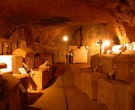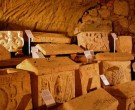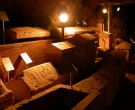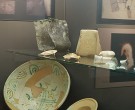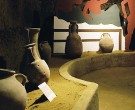> Home > What to visit > Museums

La Città Sotterranea - Museo Civico Chiusi
MUSEUMS
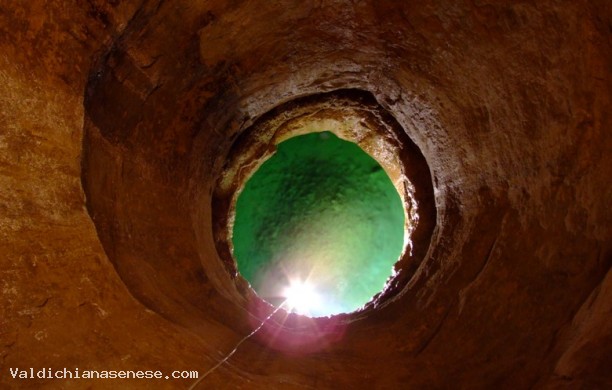
PHONE NUMBERS AND TIMES
La Città Sotterranea - Museo Civico
53043 Chiusi, Via II Ciminia, 2 (da piazza XX Settembre)
Telephone 0578 20915 - 334 6266851
Website: https://www.museisenesi.org/museo/museo-civico-la-citta-sotterranea/
Business card (vCard)
ORARI DI APERTURA E VISITA:
Tuesday to Sunday from 10 to 13 and from 15 to 18; closed on Mondays and Thursdays.
TICKETS: Promo € 3.00; free up to 18 years.
Testo: Museum of Chiusi “ The Underground Town”
The Museum of the Underground Town of Chiusi, presents itself through its three sections , as a valid didactic tool ,that illustrates the complex archeological, historical and geographical reality of the town of Chiusi. The first section, located in the Palazzo delle Logge , on Bassa Ciminia Street, gathers the chronicle of the diggings of the Etruscan gallery web ,that extends itself under the modern town; chronicle , that is strongly connected to the research on the figure of Porsenna. This character, whose historical vicissitudes are somewhat mythological, was a powerful Etruscan lucumone ( a very important political and religious figure) that at the end of the VI century B.C., declared war to Rome. The myth of Porsenna is tied to that of the Mausoleum, where he should have been buried and to that of the extremely rich treasure hidden there. As a matter of fact, the legend , handed down to us by the Roman naturalist Plinius, the Elder , tells us that the powerful lucumone’s sepulchre is located “ under the town of Chiusi”, protected by an inextricable tangle of tunnels that create a true labyrinth. For many centuries it was believed that the many Etruscan tunnels dug under the town would take one to the fabulous treasure buried with the Etruscan lucumone, and it’s for this reason that many explorers and adventure seekers ventured under the town, leaving suggestive and legendary tales of their enterprises while searching the treasure of Porsenna. The section of the Civic Museum of Chiusi, named “the Labyrinth” deals with this subject, through the use of plans, didactic panels and archeological findings, found during diggings in some parts of the tunnels. The second Museum section, dedicated to the “Productive Activities”, is hosted in the ancient palace Bonci-Casuccini, in the rooms that were once destined as warehouses for the homonymous family. Tools connected to the exploitation of Lake Chiusi and a few maps that illustrate the development and the following contraction of the marsh in the lower area of the Val di Chiana, are exhibited in the entry hall of this section. In the second room , there’s a lathe and a few Etruscan , Roman and medieval vases, that testify the importance of Chiusi in the manufacturing of pottery, throughout the ages. In the last room, the office of the farm manager has been reconstructed and a few XIX and XX century agricultural tools are exhibited. Finally, one descends in the underground , to find a few underground dwellings , built in modern times, drawn from ancient Etruscan tunnels and used as cellars , annexed to the Bonci –Cassuccini’s territory, until the middle of the XX century. From these rooms, one proceeds to other hypogeum spaces, that develop for about 140 meters under the historical center of Chiusi, where it’s been created the third section of the museum, dedicated to Etruscan epigraphy. As a matter of fact , in this section, we find a great corpus of over 500 Etruscan funerary inscriptions amid cinerary urns and inscribed tiles. Therefore, this part of the museum is dedicated to Etruscan epigraphy and constitutes the greatest epigraphic exhibit in the world, open to the public. By visiting this museum, one comes in contact with one of the most interesting aspects of Etruscan civilization: writing. As a matter of fact, by reading the inscriptions, it’s possible to recognize the letters of the alphabet and to understand how the language of these ancient people had evolved through five hundred years of history. Finally, at the end of the tour, the visitor can look upon a monumental well, realized by the Etruscans, to draw water from a small natural lake, 30 meters deep. This way, one can appreciate the mastery of these ancient people in realizing excellent hydraulic works.
STAY NEARBY
LA BADIOLA
CHIUSI
Large farmhouse immersed in the romantic setting of the Sienese countryside provides hospi...LA FATTORIA
CHIUSI
The Fattoria is an old farmhouse of the 18th century situated in a particuraly quiet place...DEL SOLE
CHIUSI
L 'hotel Del Sole è un piccolo albergo immerso nel verde delle colline toscane, sit...DINING & ENTERTAINMENT NEARBY
Teatro Mascagni
CHIUSI
A dare i natali al teatro di Chiusi è l'Accademia dei Filateti, fondata nel 1818 e ...Clev Village Multisala
CHIUSI
...Teatro degli Arrischianti
SARTEANO
Il Teatro Comunale degli Arrischianti di Sarteano è all'interno del Palazzo Comuna...



